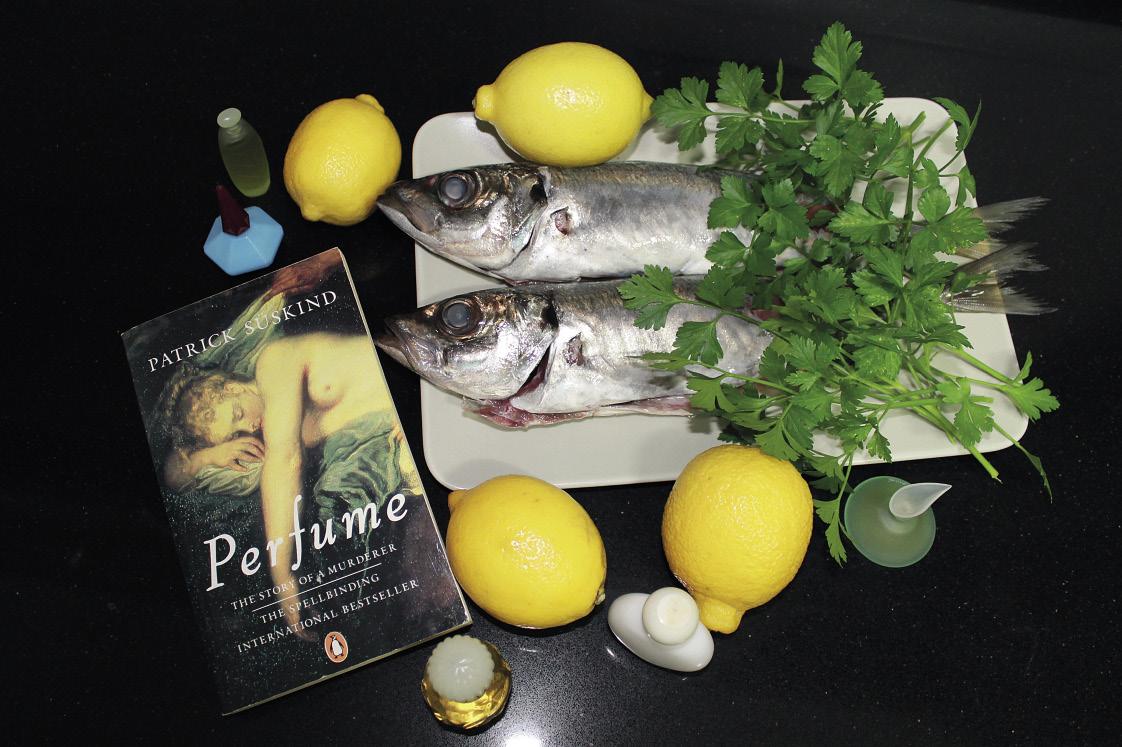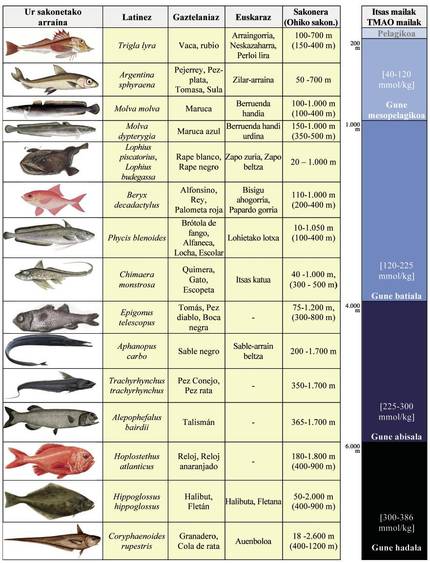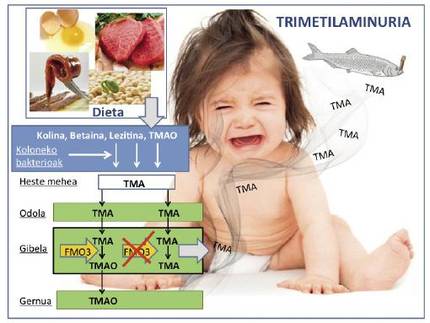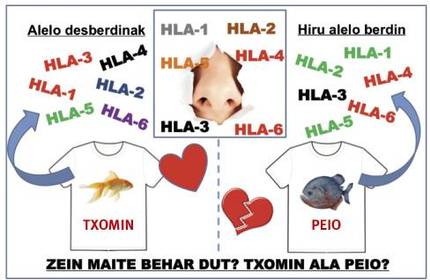Honey, what a smell of your skin!
2016/09/01 Cancio Uriarte, Ibon - Biologian doktorea Iturria: Elhuyar aldizkaria

Fresh fish hardly contains a sunda or characteristic odor attributable to fish. They have a soft smell, not very different from the species to the species. In the post-mortal hours different smells appear between freshwater and saltwater fish, as the marine fish sprout from trimethylamine. What is that?
Marine fish face a serious problem as they are in constant competition against salinity. Fish are at risk of dehydration because the water in their cells leaks. Unlike the economy, where money moves from the pockets of those who always have little, the water from the cells of marine animals tends to equal the concentration of salts through the membranes. Competition, therefore, is contrary to the fact that cod does not turn into dry salty!
In this context, marine invertebrates have given up the struggle to maintain water. Its internal osmolarity conforms to staying at sea level (they are osmocosmetics). They are isoosmotic with the external medium, with an osmolarity of 1,100 mOsm/kg in the cells. However, these high values are not due to the high levels of the cell ions, as these high levels of salt would damage the proteins and lipids of the cells. On the contrary, cells accumulate osmotically active organic solutes to reach these high osmolarities. Often these osmolites are neutral amino acids, polyols, urea and methylamines.
On the other hand, most marine vertebrates are osmorregulators and are converted into hypoosmotics with respect to the sea by their organs specialized in the active transport of water and ions (kidneys, gills). But to survive they need to maintain high levels of osmolito. The internal osmolarity of marine fish is 350 mOsm/kg and the main osmolito is a methylamine: trimethylamine N-oxide (TMAO). Upon death, when fish begins to deteriorate its tissues, TMAO becomes trimethylamine (TMA). This MAT is very volatile at high pH and provides aged fish with a characteristic smell that reaches the nose. The TMA is also responsible for the smell of cephalopod and crustacean fish, as the common squid accumulates 86 mmol/kg TMAO. Are you one of those who put lemon on fish and tails? Well, the acidity of vinegar, lemon and tomato stop this pride of TMA, covering the smell. Please, home, if I invite you to eat fish, I do not ask for lemon. Because the fish in our house is fresh!

In some fish species, such as gats (cod, hake, berruenda, cod, paneca...), TMA production can be started relatively quickly due to the tmao-demethylase enzyme. All fish species, in general, increase the population of bacteria they had when they were alive within 24-48 hours of their death. Facultative anaerobic bacteria, growing to critical levels, use TMAO as an electron acceptor to produce TMA. In most habitats and geographic areas, the main producer is Shewanella putrefaciens, another bacterium typical of fish.
Thus, TM levels are measured as indicators of fish quality and electronic noses are sometimes used for measurement. But not all fish have the same level of maos in their muscle.
The intense smell of deep-sea fish!
I do not know if it is formed by odour rankings between fish species, but at the level of tma there are differences. Here the champions are deep sea fish. In the middle meso and batipelágico there are fish that offer us very fine bites. As we have exhausted the fish stations of the platform, we have been showing a growing trend towards international deep water in search of fish. In fishing, deep fish are those caught below 400 m: maruca, palometa, halibut… (Table 1, Figure 2).

With the depth appears another type of stress: the hydrostatic pressure (10 more atmospheres per 100 m). In the deepest depth, in the middle hadar (6,000-11,000 m), the pressure is about 1,000 atm (we live in 1 atm and put 3 atm of pressure on the wheels of the car). Therefore, deep-sea fish should avoid air-filled structures, swimming balloons and others. And remember the effect that you notice in the ears at high pressures. But this does not solve the problem, since proteins also suffer pressure. Therefore, deep-water fish have resorted to the use of piezolites (organic anti-pressure molecules) to protect proteins. And what is the piezolite par excellence in fish? TMAO... In addition, there is a linear relationship between the depth and the levels of the sea fish. TMA levels range from 40-50 mmol/kg in surface, 150 mmol/kg to 1,400 m and 261 mmol/kg to 4,850 m.
In the hadal fish Notoliparis kermadecensis, which is usually found at 7000 m, a concentration of 386 mmol/kg has been measured, which raises the internal osmolarity of the fish to 991 mOsmol/kg. This data would explain why fish has not been found below 8,400 m. The level of tma needed at that depth would turn fish into hyperosmotics. Therefore, the TMAO accumulated at these depths would force fish to adjust to freshwater conditions.
On the other hand, in the elasmobranchs (sharks, blankets and rays) something else happens. In this group many species are bathypelagic and use urea as the main osmolito, which gives them a strong smell of urine. The problem is that urea has a proteolytic effect. So, do these fish need something to protect proteins and what better than TMAO? The aromatic cocktail appears in a magical concentration in most species: for each part of the urea, half of the mao-part. So complete our classification and, from now on, after going to the fishmonger, organize fish odour tests in your homes!
Disease that smells like fish to humans
There are people who suffer from bad smell of fish. Very deep! I don't mean hygiene, sweat or halitosis. We are facing a rare shameful metabolic disease: fish breath syndrome or trimethylaminuria (TMAU). Flabin-monoxygenase 3 (FMO3) has been caused by genetic errors on the enzyme and about 40 mutations have been catalogued in this human gene. When FMO3 does not work or does not produce enough, the body cannot metabolize MAT.

The components of egg yolks, legumes, red meat and fish in the diet produce nitrogen metabolites such as choline, carnitine, lecithin and TMAO. Through them, our bacterial flora generates TMA. You and I are protected by the FMO3 of our time and we turn TMA into odorless TMAO. Those affected by the disease, on the contrary, release the MAT from sweat, urine and breathing, causing a strong breath of fish (Figure 3). For unknown reasons, it is a more widespread disease in women and is conditioned by conditions related to sex hormones. But if we stay away from the smell of fish? What did our Jean-Baptiste look for?
That aroma that separates us
Yes, we have the smell that is ours and unique, our “eau de nosotros”. Sorry, our “eau de ni neu”. In an already mythical work, Wedekind and his friends “demonstrated” that there is something in the air of our environment. Several boys delivered used t-shirts to 121 girls from the University of Bern to smell and choose their favorite. The boys who wore the dressed t-shirts were 3 days without showering and without perfumes. After the test, a genetic analysis of all girls and boys was performed, analyzing the genotype of the Central Complex Histocompatibility (DCA) genes of the participants. The “smells” chose significantly the boys’ shirts with the most diverse alleles of the DHK. Sexual selection apparently uses olfactory mechanisms in fish, birds, reptiles or mammals. The genetic composition of our DG provides us with special odors: our sexual ID!
HKN genes produce a large number of vertebrate cell membrane receptors (HLA molecules) capable of associating different antigenic peptides. These antigens present themselves to T lymphocytes in our immune defense to separate the cells themselves from the strangers. Many of the peptides that retain and present HLA molecules come from the proteolytic processes of our cells in everyday life. In the cells that die constantly, these peptides are detached from the HLA receptors and because they are volatile they give us smell. The number of DCA genes in humans (including other vertebrates, including fish) is high and is also among the most polymorphic genes known in each gene. For example, H. sapiens has 1,600 different alleles for the HLA-B locus. Therefore, there are no two human beings with the same supply of HLA molecules, nor that have volatile peptides. In addition, it should be noted that in humans 1,000 out of 24,000 genes produce odour and pheromone receptors, each specific for one or more odour molecules. For their discovery, Linda Buck and Richard Axel were awarded the Nobel Prize in Medicine in 2004. 4% of our genome is therefore responsible for smelling. For this there must be a reason well grounded in the mechanisms of evolution. Darwin is always right! What if that huge variety of genes had the responsibility to choose our partner with smell?

According to the hypothesis of the red queen, it must be important to find suitable partner. And as a result, the grain that most resembles the supply of HKN, like our relative, is rejected by our nose and chooses your partner among the specimens more different from ours. Our children will always have a new combination of JJGG alleles when mixing the proper provision of “the two”. In this continuous competition with pathogens, they want to live on our back and we want to leave them out. It is about complicating things to pathogens, forcing them to overcome their own “anti-missile belt” built by the HKN system of each human being, in a continuous escalation “of antibacterial weapons. When they fit our CMM endowment we have children. And these new human beings have a new defense system that pathogens must overcome. But that can be “wood” for another article!
Research on t-shirts has also allowed the business. The dating company GenePartner analyzes 6 DG genes for 100€. They then recommend your partner to appear in their databases with a combination of alleles different from yours (Figure 4). Or when you think you have found the pinpilimaux of your heart, you can analyze your genes. If they are too equal, goodbye Ben-Hur! Yes, if they are different you are assured: a loving future, wonderful sexual intercourse and healthy children perfectly trained in the fight against strife.
Let us, therefore, leave perfumes and perfumes, take out our smells and pass through the smells, bars, schools, squares, mountains and cinemas. Let us fall in love with our lands and the hidden messages they carry. Let us be prudent and nose-minded human beings. And in that situation, where do I, this anosmic marginalized man, stay? In paradise! To smell and smell good! And because I recognize him the sweetest and most favorite steam for me.
BIBLIOGRAPHY

Gai honi buruzko eduki gehiago
Elhuyarrek garatutako teknologia



